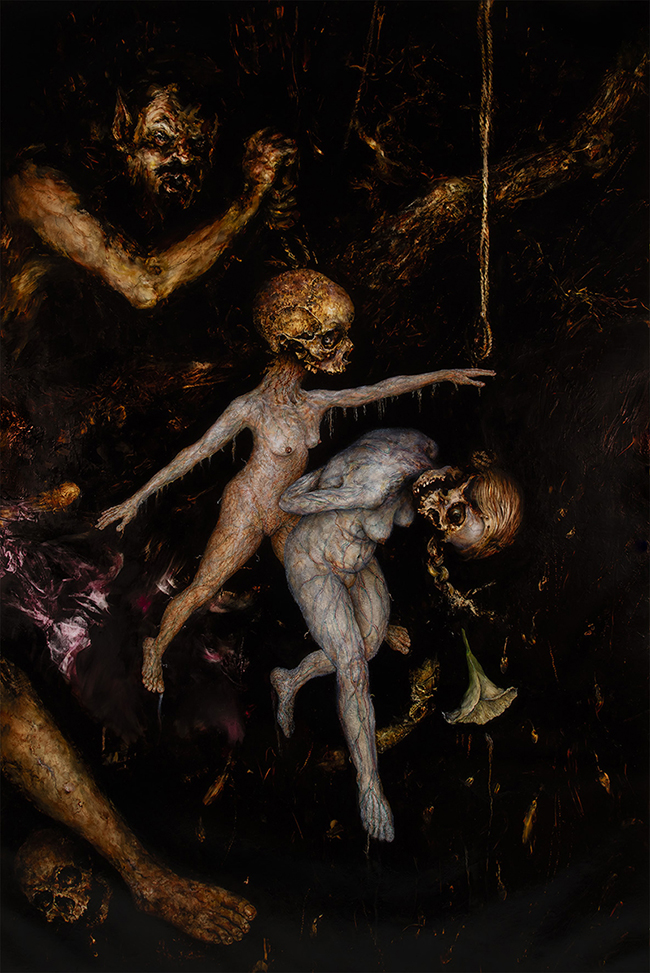Terry Taylor’s work doesn’t whisper. It enters the room like a storm and sits with you. Her paintings are not there to be admired from a distance—they demand confrontation. They show humans as they are: stripped, tangled, undone. In Taylor’s world, flesh is memory. Spirit is weight. Nothing is hidden.

Born from a raw and visceral sensibility, her practice explores the elemental forces behind human behavior. Taylor paints what she calls “the naked existence of humans.” There’s no room here for pretense. Vanity, ambition, identity—they’re peeled away. What’s left is the creature beneath. And she doesn’t turn away from it.
Her 2024 oil-on-linen piece, Eros and Thanatos, measures 175 x 115 cm and carries this philosophy to its core. It’s not just a painting—it’s a reckoning. The title comes from two opposing drives in Freudian theory: the life force (Eros) and the death drive (Thanatos). But Taylor doesn’t reference psychology to flatter intellect. She paints it because she feels it in her bones. Because it’s real.
In the work, we see Eros not as a seductress but as a banished figure. Her head is lowered, her hands clenched behind her back, almost like a prisoner marching to her own end. Her hair, a symbol of sensuality and fertility, has become a weight. A burden. It drags her down. The promise of pleasure collapses under the gravity of mortality. And watching from the dark is Thanatos—massive, brooding, unmistakable. He’s not hidden in the shadows. He is the shadows. He doesn’t move; he directs. His foot seems to anchor the entire composition.
It’s hard not to read the work biographically. Taylor has spoken of her twin sister, who died at birth and was buried in a mass grave near Geelong Hospital. The death was anonymous, bureaucratic—just one of 50 babies. The trauma wasn’t just the loss, but the erasure. The not-knowing. In Taylor’s words, “Life and death are on the same line.” This painting walks that line.
The figures in Eros and Thanatos are skeletal and swollen at once—flesh that remembers being spirit, spirit that hasn’t forgotten flesh. Their skin is mapped like a root system or riverbed, as if veins are tributaries. There’s a constant, quiet motion beneath the surface, like life refusing to sit still. But there’s also rot. Bone. Collapse.
Taylor often includes skulls in her work, not for the sake of shock but as a call to memory. To presence. The skulls aren’t symbols. They’re facts. They’re reminders of what came before, and what’s coming. She says, “My paintings are of the living dead and of the dead living.” It’s not romantic. It’s real.
And yet, even in their grotesque truth, her figures are full of liveliness. Not beauty in the traditional sense, but vitality. They move. They struggle. They suffer. They exist. Taylor’s brush doesn’t simply paint anatomy—it drags up the invisible. Desire, fear, shame, memory. The things we try to bury but can’t.
In the painting, there’s also a single flower—a white trumpet-like bloom. It floats near the lower edge, away from the chaos. A quiet gesture. It could be a symbol of mourning. Or a drug. Or both. Taylor doesn’t explain. She doesn’t need to. The point isn’t clarity. It’s feeling.
What makes Taylor’s work so affecting is that she isn’t detached from her subjects. She’s in there with them. You get the sense she’s not just painting a figure—she is the figure. Her body remembers. Her grief remembers. Her brush obeys.
And the result is work that doesn’t ask to be liked. It asks to be met.
Terry Taylor doesn’t make art to please. She makes it to understand what can’t be understood, to face what most people turn away from. Her work is brutal. Honest. And alive. In a time when surface often triumphs over substance, Taylor digs deep—into the earth, into the body, into memory. She reminds us that to be human is to be haunted, but also to keep moving. Even when it hurts. Especially when it hurts.

